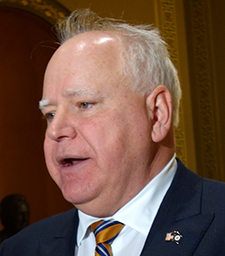Haley Comfort Systems, which sells heating and cooling systems in Rochester, has noticed a growing interest in air source heat pumps over the past couple of months.
So much so that Nicole Haley, the company’s marketing director, said they’re planning an April trade-in event to exchange old air conditioners and upgrade to new heat pumps. They also will offer a credit for new heat pumps and help explain to customers the tax breaks and rebates aimed at making the climate-friendly, electric technology cheaper.
Haley guessed heat pumps make up 5 to 10% of sales. But only for now. “I could see that number really increasing this next year or two,” she said. “I think we’re just kind of right at the forefront of seeing that big increase.”
DFL state lawmakers who control Minnesota’s Legislature are hoping to make air source heat pumps even cheaper, at least for some, in a bid to spark demand for a product that can reduce carbon emissions. That’s why they’re poised to approve somewhere around $10 million for heat pump rebates up to $4,000 — on top of new federal incentives — as part of an unusually large climate and energy budget under consideration by legislators that could easily top $300 million.
Those Democrats haven’t settled on an exact plan for the cash. House and Senate leaders this week announced how they would prefer to spend the money, and will have some significant differences to sort out along with disagreements over policy questions.
But so far, it’s clear that Democrats agree on directing cash into a smorgasbord of rebates, tax incentives and grants for climate technology. That includes solar panels on K-12 schools and other public buildings, but also electric vehicles, electric school buses, school heating, cooling and ventilation upgrades, plus home heat pumps and energy efficiency work like insulation.
Republicans have objected to much of the DFL vision, arguing in favor of less government regulation instead of more spending, for instance. But with Democrats in full control of state government, the GOP can do little to stop or alter the DFL agenda.
A bigger-than-normal energy budget
While the final product on climate and energy for lawmakers is still uncertain, one thing is definite: spending on the issue will be far higher than in recent years.

One reason for the more expensive budget plan is because Democrats are in control of the House and Senate and view climate change as a threat that can be partially addressed by spending lots of taxpayer money. But another reason is simply that legislators have more money on hand because of a historically large $17.5 billion surplus.
That energy and climate budget is also not the end of climate spending. Other parts of the state budget might include large sums earmarked for transportation, reforestation and other initiatives that could trim carbon emissions.
Again, there are many major differences already in the “omnibus” bills rolled out by House and Senate DFLers this week that outline how they plan to spend that energy budget and what policy provisions they might implement.
For instance, the Senate proposed studying advanced nuclear technology, an idea the House has balked at. Senate DFLers also hope to subsidize upgrades to a high-voltage transmission line between North Dakota and Minnesota to help the Duluth-based utility Minnesota Power transmit energy. The measure is not in the House plan.
Another example of potential discord is a House DFL measure that would require utilities to build a certain amount of energy storage, which utility companies have objected to as an unnecessary mandate. Senate Democrats do not have the legislation in their plan.
Nevertheless, there are many similarities between what Democrats in the House and Senate want to do.
One point of agreement is the most expensive item: $115 million for a state “competitiveness fund” to match federal dollars for climate and energy projects in Minnesota.
DFLers also hope to use $15-$40 million to boost an existing program that pays for solar panels on top of K-12 schools. And Democrats proposed $55 million in the House and $24 million in the Senate for state-funded “pre-weatherization” efforts, which are fixes to homes that enable energy efficiency projects like upgraded windows.
The House and Senate each proposed an electric school bus grant program at a cost that ranged between $7-14 million, and both have millions to upgrade home electric panels.
One large pot of money would be for EV rebates. The House and Senate bills would create a $2,500 rebate for eligible people to buy or lease a new EV under a price limit. There would be a separate $500 rebate for used EVs. And Minnesotans below an income threshold would qualify for an extra $500 for a new EV and $100 for a used one. People who have already received an EV rebate or tax credit from the state would not be eligible. The House proposed more than $17 million for those rebates compared to $4 million in the Senate.
There are many other similar programs in the bill for consumers or utilities to subsidize climate technology.
Republican opposition to DFL plans
Democrats hailed their bills as moving the dial to reduce carbon emissions and spur the advance of greener technology.
But Republicans objected to much of the energy and climate omnibus plans. GOP lawmakers praised the Senate bill for including the nuclear study and money to help communities losing large power plants. But they argued the legislation would result in unnecessary government interference in the private market, higher power bills or cause taxpayers to subsidize the wealthy.

“I have not been able to buy an electric vehicle. It’s cost prohibitive for me,” Mathews said during a Senate hearing. “But I will be paying for other rich people to get a rebate for their electric vehicle.”
During a House hearing on Tuesday, Rep. Chris Swedzinski, R-Ghent, said he preferred to return all the money in the RDA to Xcel Energy in an effort to slash power bills and focus on lowering the cost of energy rather than use money to focus on “special projects.” He has previously been against the electricity storage mandate and other regulations on utilities.
Nevertheless, Democrats plowed ahead with their omnibus bills. Once each is passed by the House and Senate, legislators will meet to hash out a final plan.
What the heat pump program does
The heat pump rebate program is emblematic of the approach by DFL lawmakers, who opted to incentivize a host of green technology rather than focus on any one issue.

About $4 million for EV rebate funds would be enough for less than 1% of electric vehicle sales in 2024, said Amber Backhaus, vice president of public affairs for the Minnesota Automobile Dealers Association.
Rep. Patty Acomb, a Minnetonka DFLer who chairs the House’s Climate and Energy Finance and Policy Committee, told MinnPost that legislators need to introduce new technology to Minnesotans and need to be moving on “all fronts” in an effort to avoid the worst impacts of climate change.

Acomb is the prime sponsor on the air source heat pump bill, which is one of those emerging technologies. The electric system can both heat and cool, and they operate by transferring heat between outdoor and indoor air. They are lauded by climate advocates because they run on electricity rather than fossil fuels and therefore produce far fewer carbon emissions.
Partridge said uptake in Minnesota has trailed other states because older versions of the technology didn’t work as well in cold weather states. She said roughly two-thirds of the state’s buildings are heated with natural gas, while the rest are a mix of propane, electric and other sources.
But Partridge said heat pump technology has made strides, even if they’re still only effective down to certain temperatures and need to be paired with a secondary heating system. The most advanced and newest heat pumps can operate down to -13 degrees, according to one assessment by the Center for Energy and Environment. “That’s really maxing it out,” Partridge said.
Typical heat pumps switch over to that second heat source between 20 and 40 degrees, according to the website of the Air Source Heat Pump Collaborative, which includes CEE and the state’s major utility companies including Xcel Energy, Minnesota Power and Great River Energy.
Haley, from the Rochester company, said the biggest barrier for people in her area is usually the cost. They’re more expensive than traditional furnaces or air conditioners. Supporters argue the pumps will save money over time because they’re more efficient and cheaper to operate. Though Haley said natural gas is cheap right now, lowering that incentive.
“Mini-split” heat pumps, which don’t use air ducts, are about $3,000 on the low end and ducted pumps cost about $6,000 at the cheapest, according to the collaborative. The more advanced pumps, or larger systems, can cost more than $15,000. Haley said those estimates are low when including costs for installation and electric work. The collaborative also says it’s common for homeowners to add additional work alongside the heat pump, like replacing a furnace. In fact, the Minnesota rebate would usually require insulation upgrades.
The Minnesota rebate as currently proposed would only be open to people who have applied for a heat pump rebate from the federal government thanks to incentives approved as part of the Inflation Reduction Act. Federal rebates for heat pumps, up to $8,000, have an income limit of 150% of the area’s median income. Separately, there are tax credits for heat pumps with no income limit that are up to 30% of a project with an annual cap of $2,000. Partridge also said utilities may soon begin offering more incentives under an energy conservation law passed by the Minnesota Legislature in 2021.
Haley said heat pumps are a growing share of their sales, and not only because of their potential for reducing emissions. “With all of the incentives that are coming out from the government it’s definitely more of an interest to customers,” she said.

0 Commentaires